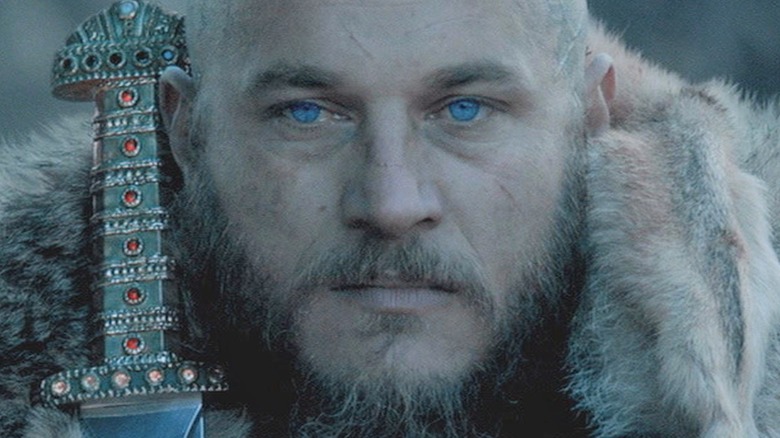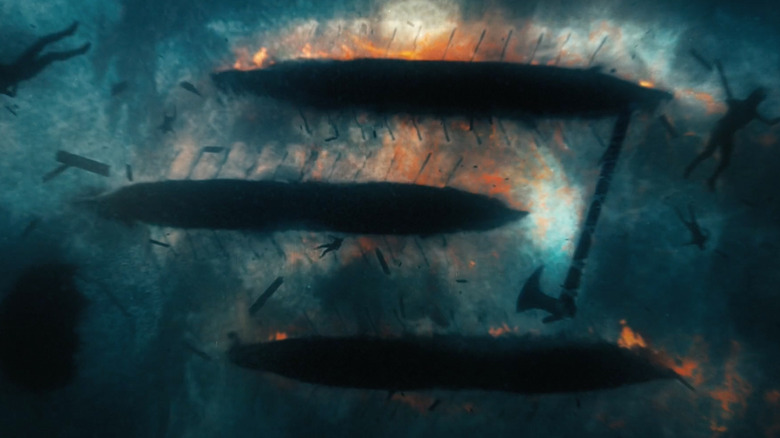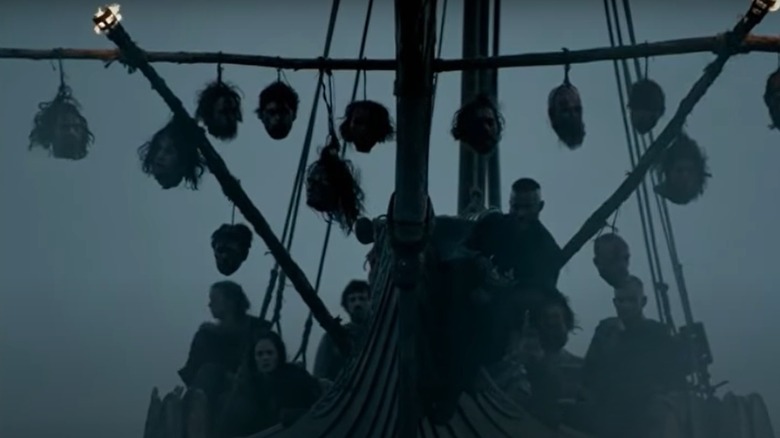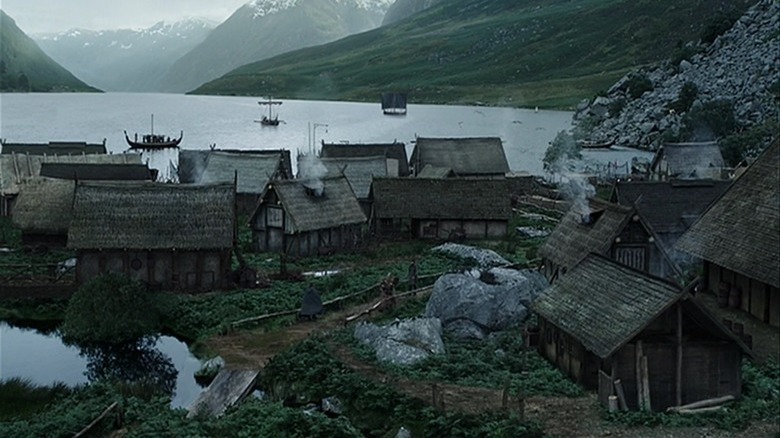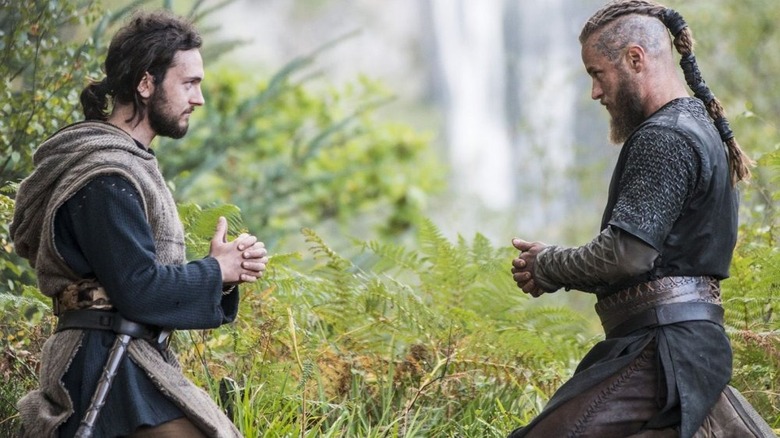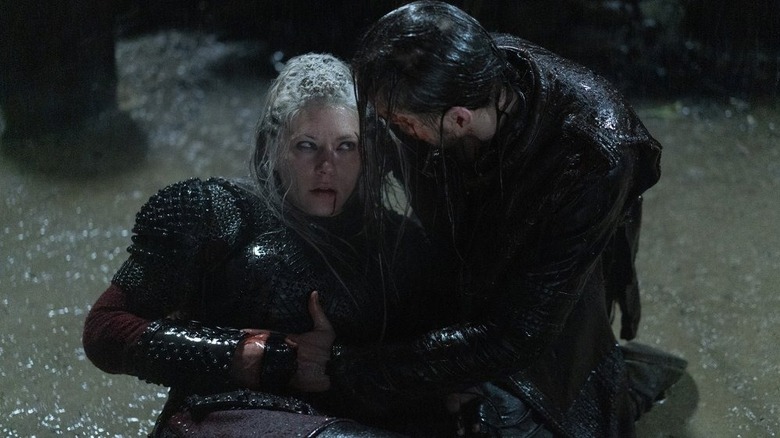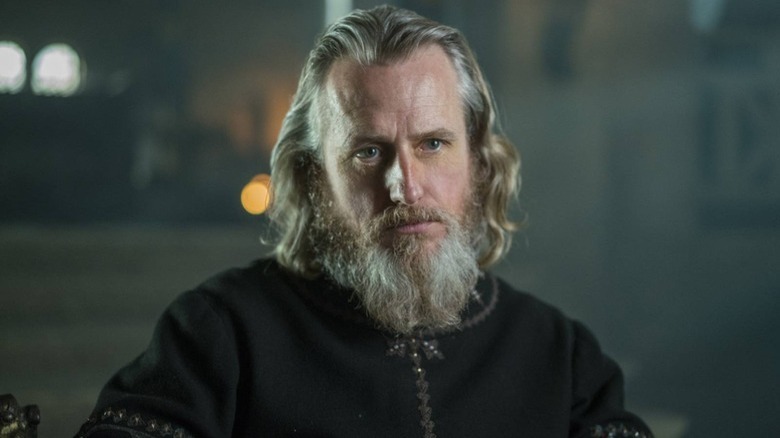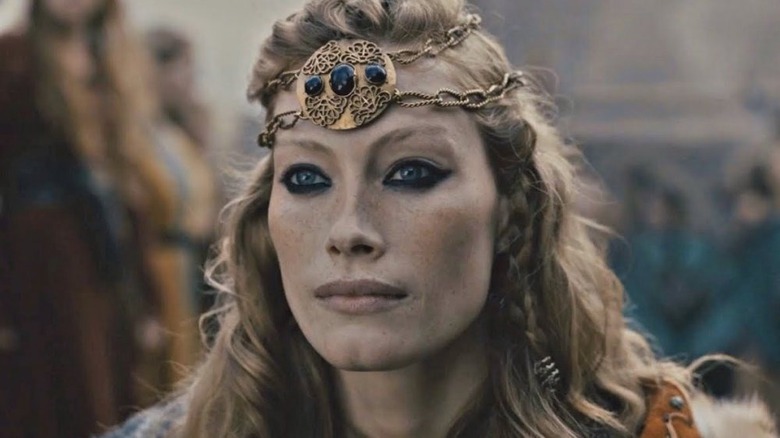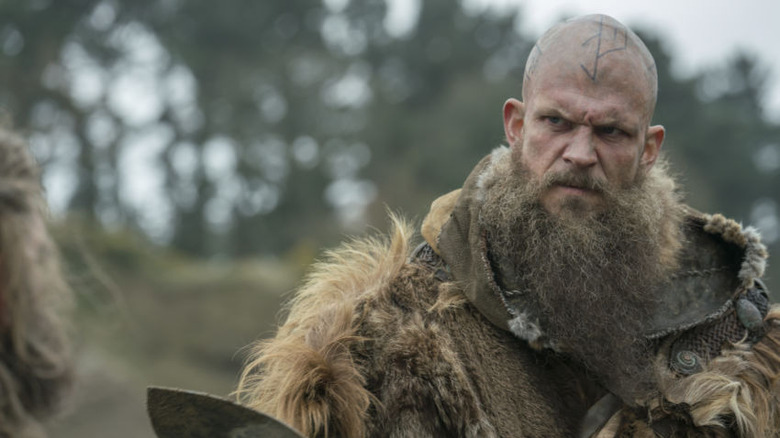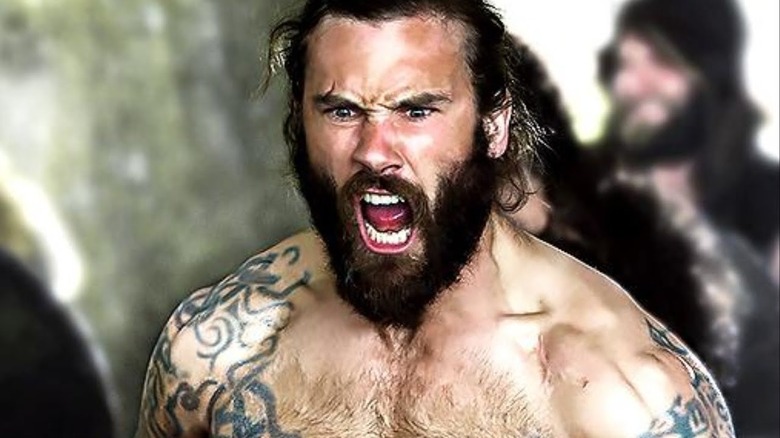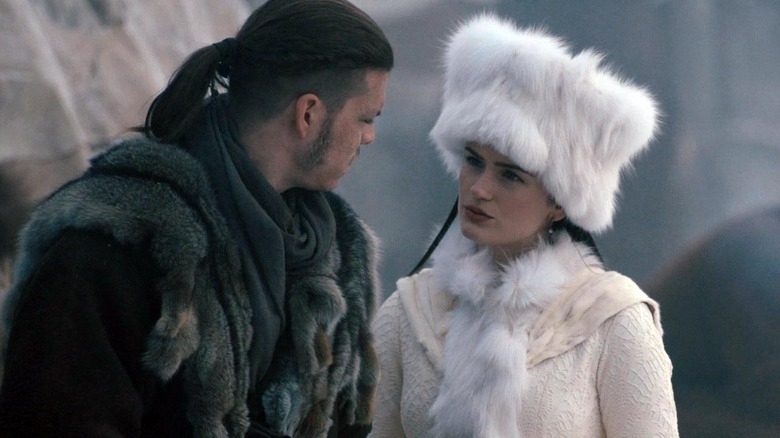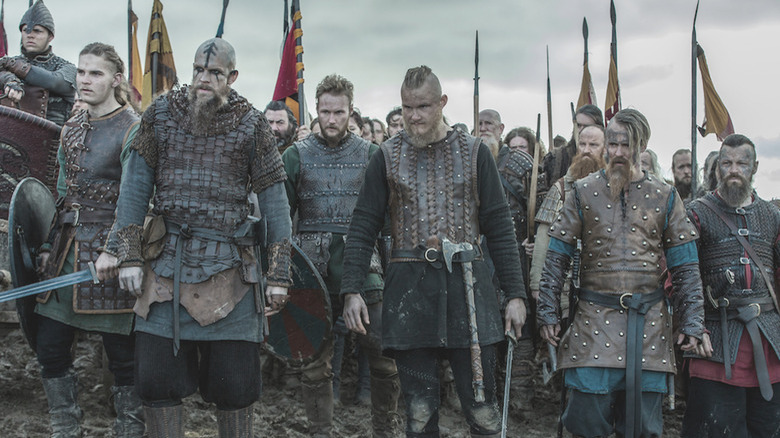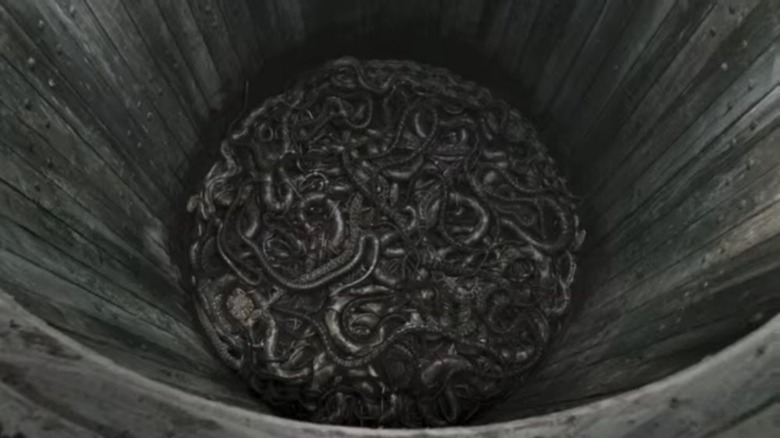Small Details In Vikings Only True Fans Noticed
Screenwriter and producer Michael Hirst has made a career out of reimagining famous historical figures, both for the small screen and the big one. The Yorkshire native popped up on Hollywood's radar after penning the Cate Blanchett-led "Elizabeth," a critically acclaimed biopic that detailed the early years of Elizabeth I's reign. Blanchett reprised the role in Hirst's 2007 sequel "Elizabeth: The Golden Age," by which point the writer was hard at work on his first TV show, "The Tudors."
"I was attacked quite a lot for 'The Tudors,'" Hirst told Creative Screenwriting. "Henry VIII is such an iconic figure that you're not really supposed to show him in any other way than he is normally shown. But it's been totally different with 'Vikings.'" The proud Brit went on to reveal that "Vikings," the saga of Ragnar Lothbrok (Travis Fimmel) and his sons, has had the seal of approval from the curator of the Viking Ship Museum in Oslo and the head of Scandinavian Studies at Harvard (despite the many artistic liberties he took with the Viking timeline). "It's had a great response from teachers, historians, intellectuals, and all people who know about the period."
It's the little things that make "Vikings" authentic as well as entertaining, though many of the show's nods and references went unnoticed by the majority of viewers. Here's our round-up of all the small details in "Vikings" that only true fans noticed. (Warning — there are spoilers below.)
The title sequence is about the nine daughters of Aegir
Fever Ray's "If I Had a Heart" is pretty haunting without any visual aid, but the song becomes even more memorable when paired with the stellar work of The Mill. The London-based visual effects studio was tasked with creating a title sequence to go with the Swedish artist's track, so project director Rama Allen played it on loop as he worked. "I had this really crazy drowning dream that night," he told Art of the Title. "One of the images of that dream was looking up and seeing the silhouette of these massive objects moving over the top of the ocean above me. I came back in the morning, and I was like, 'I've got it! This is going to be a drowning sequence!'"
To help make his vision a reality, Allen turned to his art director Audrey Davis, who discovered the perfect god for their particular needs. "I was researching a lot of Viking folklore and came across one of the Viking gods — Aegir — and his nine daughters, who were all references to different kinds of waves that the Vikings would see in their travels," Davis explained. "So that's kind of where we got our story." The title sequence was nominated for an Emmy, and drowning became a theme throughout the show. Ragnar and his son, Ivar (Alex Høgh Andersen), cheated death when giant waves wrecked their ship during Season 4, but many others weren't so lucky.
Travis Fimmel's severed head dangles from one of Ragnar's ships
"Vikings" never shied away from showing the true nature of warfare in the Viking-age, delighting viewers with numerous bloody battles over the course of six seasons. According to the show's makeup and prosthetic designer, Tom McInerney, his team had to make "hundreds and thousands of liters of blood" to keep up with demand. "We have to make approximately ten 50-liter barrels of blood for every battle scene, and the challenge was to make something that doesn't stain costumes or the actors' skin," he told SBS. "We've invented a new type of 'blood' made of sugar syrup and food coloring that washes out."
Making fake blood is a relative walk in the park compared to fake heads, however. In one memorable Season 3 scene, Ragnar attaches the severed heads of conquered foes to his ships in a (very successful) attempt to terrify the Mercians. "I got a phone call saying I had 40 heads to make — fast," McInerney revealed. "To speed things up, we enlisted any cast and crew we could find." They did their best to meet the deadline, but McInerney admitted that they took a cheeky shortcut, one that only eagle-eyed "Vikings" fans will have noticed. He revealed, "If you look closely, Travis Fimmel's head is in there too."
Kattegat has its own unique accent
Named after a narrow stretch of sea between Denmark and Sweden, Kattegat was never a real Norse village, but that didn't matter to the people who were set to inhabit it on "Vikings." Speaking to Collider in 2013, Katheryn Winnick revealed that all the actors who were based in and around the strategically important settlement worked on a Kattegat-specific accent. "We created a bible of sounds that the cast could really tune into and use as a source of a base because we have such an international cast," the Canadian actor, who played shield maiden and longtime fan favorite Lagertha, said. "It was important for us to create a family of words and sounds, just so we all were part of the same village."
Things got a bit more complicated when the people of Kattegat and other Norse characters began interacting with the Saxons and the Franks. When this happened, one group tended to stick with modern English while the other temporarily reverted back to the ancient language of their people, and Michael Hirst had a team of specialists on hand to make sure this sounded as genuine as it possibly could. Old Norse and Old English are scarcely heard nowadays, but Old Low Franconian is even rarer. The use of it on the show marked the "first time the language has been heard in 1,000 years," dialect coach Poll Moussoulides told TV Insider.
Ragnar barely said a word during the Season 2 finale
Travis Fimmel gave a masterclass in silent acting during the "Vikings" Season 2 finale ... but barely anyone noticed. The tenth and final episode of the season is called "The Lord's Prayer," and the famous Christian invocation is all that Fimmel wanted to say during the entire runtime, according to Michael Hirst. Speaking online during the Comic-Con@Home "Vikings" panel in 2020 (via the Express), the showrunner revealed, "Travis said to me, 'Do you think, perhaps it would be a good idea if I don't say anything in this episode except the Lord's Prayer?' And I said, 'Well, you are in a lot of scenes,' and he said, 'Yeah, but I can do it by looking, I don't need to say anything.'"
It was certainly a "radical idea," Hirst said, though it was one that he liked. He took Fimmel's suggestion on board but told him to make it their little secret. "I said, 'Don't tell anyone. Don't tell MGM. Don't tell History.' Because no one would allow it, your lead character is not saying what's on the page that they had approved," Hirst continued. "So we did it, and I don't think anyone noticed, nobody noticed that he didn't say anything because he was still in the scenes." Aside from the odd blunt response en route to his meeting with Athelstan (George Blagden), Ragnar doesn't speak a word until he meets with his Christian captive turned confidante to learn the Lord's Prayer.
Lagertha's final scene contained dialogue from her first audition tape
While Ragnar's death at the hands of Ivan Kaye's King Aelle (who, just as real history suggests he did, tossed the captured Viking into a pit of venomous snakes) was arguably the show's most devastating, losing Lagertha in such underwhelming circumstances was also a massive blow for fans. Ragnar's first wife is stabbed to death by his hallucinating son Hvitserk (Marco Ilsø) in the Season 6 episode "Death and the Serpent," and her funeral — which takes place in the following episode, "The Ice Maiden" — is a real tear-jerker. As she joins late husband Ragnar in Valhalla, she tells him, "In my dreams, we are always together."
These are words that Winnick spoke the very first time she played Lagertha on tape. "Vikings" fans who've seen the actor's audition will no doubt recognize the line because it's also the very last one she speaks on the show. It was a real "full circle" moment for Winnick, who called it "a little fun fact to the fans" during the show's Comic-Con@Home panel in 2020. "I just love that last moment that you did where Lagertha falls in the water, and she lands right next to Ragnar," she told showrunner Michael Hirst.
Vikings is full of T.S. Eliot's poetry
By the time "Vikings" wrapped after six seasons, fans of the show were well aware of the creator's love of T.S. Eliot. Michael Hirst, who studied English and American literature at the University of Nottingham, referenced Eliot's poetry in his "Vikings" dialogue on numerous occasions, sometimes rather subtly. For example, Helga (played by the showrunner's daughter, Maude Hirst) uses a line from Eliot's "Gerontion" in Season 3's "The Dead," and pieces of his poem "The Waste Land" have been uttered by everyone from the Seer (John Kavanagh) to King Olaf (Steven Berkoff).
Perhaps the best example of Hirst lifting directly from Eliot came by way of actor Linus Roache, whose character, King Ecbert of Wessex, recites lines from "Four Quarters" as he gazes out of his window towards the end of Season 3. "The reason that I thought I could do that is because the lines are about time," Hirst told Creative Screenwriting. "I thought that that was really what I was talking about within the show — connecting past, present, and future. ... I thought people would pick up on it and think I was crazy, but no one picked up on it until I mentioned it in an interview." According to Hirst, he tried to tweak the lines to make Ecbert's musing sound more appropriate for a Saxon king, but he found that "everything sounded stale and poor when compared to Eliot."
Vikings has a 'Beatles connection'
Like most people of his generation, Michael Hirst loves The Beatles. Being a creator of historical dramas, you'd think it would be difficult for him to incorporate his passion for the iconic band into his work, but believe it or not, "Vikings" contains numerous nods to the British quartet. "I've stuck many things in the show that privately, to me, have a Beatles connection," Hirst said during an interview with SBS. He went on to reveal that he began to see Alyssa Sutherland's Princess Aslaug as the Yoko Ono to Ragnar's John Lennon during Season 4, when Yidu (Dianne Doan) arrives in Kattegat.
An illegitimate daughter of a Chinese emperor who ends up in Europe after being captured by pirates and sold into slavery, Yidu became the object of Ragnar's infatuation during a drug-fueled spell (she introduces him to what appears to be opium). Discussing the arc with SBS, Hirst said that he was "thinking about Yoko and John, and how when Yoko felt that John was getting a little tired of her and it wasn't working out, she sort of gave John to her assistant, May Pang." He added, "There's something similar going on with Aslaug and Ragnar. It's not a simple transference, but in my mind, there were aspects of that."
The beards are all fake
Some truly impressive beards popped up on "Vikings" over the years, but in the vast majority of cases, thanks was owed to the costume department rather than the guy rocking it. If you look closely enough, you'll notice that the brilliant crumb catchers featured in the show are totally fake, but only if you really squint — as elaborate as some of them are, they're generally very convincing. The show's makeup and prosthetic guru, Tom McInerney, managed to perfect the art of the fake beard during the course of his time on "Vikings," though some trial and error was needed.
During the early seasons of the show, the actors wore yak-hair beards that were personalized to fit the shape of their faces. "This method was posing problems because it didn't allow for much mobility for the actors to perform, and when they ate food, it got messy," McInerney told SBS in 2017. "We cheated a bit and now hand-lay all the beards on to the actors' faces and use little ties that we've developed here to keep them secure. It's sped up the process considerably and eliminates the micromanaging of facial hair." When he sat down for an interview with Australian grooming company Milkman that same year, McInerney was asked to name his all-time favorite "Vikings" beard, and it was a tie. He said, "For me, on this show, it was both Floki's and Ragnar's beards."
The hidden meaning behind Rollo's wolf tattoos
It probably won't surprise you to learn that, like the beards, the tattoos you've seen on "Vikings" over the years are not real. "We developed a tattoo paper much like a transfer," the show's top makeup man, Tom McInerney, told SBS. "It's actually made in the west of Ireland, and we print it onto decal paper and then use sterilized water to apply to the skin." As for how they remove the tattoo, McInerney explained that they had a "special gel which goes on the skin first and dissolves the adhesive in the tattoo, allowing us to get the actor out faster." McInerney's streamlined process saved many actors from extra hours in the makeup chair, Clive Standen included.
The British actor played Ragnar's brother, Rollo, a feared and very real Viking who decides to start a new life in Frankia, away from the shadow of his successful sibling. Standen appeared in 45 episodes of the hit History show, and as McInerney couldn't help but point out during one behind-the-scenes featurette about Rollo's tattoos, the actor removed his shirt in many of them. As a result, keen-eyed fans will no doubt have noticed that Rollo has two wolves tattooed onto his upper body, and they're not just any wolves. According to McInerney, they are supposed to represent Hati and Skoll, twin wolves that pursue the sun and the moon in Norse mythology.
They never wear the same outfit twice
Many of the outfits seen in "Vikings" scream function over fashion, though the show has pushed the boat out with the odd elaborate get-up on occasion. "The Vikings were very adept at dying furs," Joan Bergin, the show's costume designer, told The Hollywood Reporter. "When we first tried to do it, the skins would frizzle up after a few days so we had to dye them right before the scene." Not all the costumes that she created were 100% suitable for the time period ("The era when every detail had to be historically accurate is gone," Bergin said, echoing showrunner Michael Hirst's approach), but that's not to say a lot of hard work didn't go into them.
According to Bergin, her costumes were embedded with subtle hints about the personalities of their owners. Simple things like hand-braiding the wool and using decorative hair could "give a life force to the texture," she told THR, explaining, "Adding this texture helps create the sense that there are complexities to the character." What's even more impressive is that the main cast of characters got a new look every week, according to the show's head of costume, Susan O'Connor. "Every single costume is unique to the person and the episode, so we rarely reuse what viewers have already seen," she told SBS.
Not a horned helmet in sight
Michael Hirst has always been open about the fact that he didn't worry too much about historical accuracy while writing "Vikings" ("It's essentially a drama, but within the limits of drama, it is as authentic and real as I can make it," he told History), yet when it comes to things like armor, the show goes for accuracy over artistry. The popular image of Vikings prior to Hirst's drama was of red-headed marauders wearing horned helmets, something that History's first-ever scripted series went out of its way to correct. "Everything I write begins with the real," Hirst said. "I don't like fantasy. It's all based on proper research."
According to Audrey Davis, the art director of the VFX house that created the show's incredible opening, Hirst and his team were adamant that the drowning Vikings shown in the title sequence must be dressed appropriately. "They wanted us to research Vikings, their history, their culture, and be truthful about it," Davis told Art of the Title. "They didn't want helmets with horns on them. That was never a real thing. Our process involved a lot of research, going to museums and looking at the Icelandic sagas, reading all the folklore."
Those were real snakes in that pit
When Michael Hirst began writing "Vikings," the plan was for Ragnar to die at the end of the first season, leaving the bulk of the story for his sons. "But, of course, once I started writing," he told Vulture, "I wanted to continue to be with him." Travis Fimmel's character survived way longer than the showrunner initially anticipated, though his eventual death is among Hirst's favorites from his time working on the show. Not only did it showcase Ragnar the tactician at his finest (he knew that his execution at the hands of the Saxons would unite his sons and the rest of the Norse world against them), but it was also brilliantly shot — with real snakes.
While the vipers that sink their teeth into Ragnar are obviously CGI, there were "about 60" real serpents in that pit with him, as Fimmel revealed during an interview with The Hollywood Reporter. "I didn't mind them at all," the actor said. "I was covered in snake poop at the end. I got bitten a few times, but that was fine — it was them pooping on me that annoyed me more than anything." According to the episode's director Ciaran Donnelly, Fimmel really was that cool about the whole thing. "He grew up on a farm in Australia and he's quite used to snakes," Donnelly told Metro. "I feel it was quite authentic in that way, and that's thanks to Travis' ability to hang with snakes."
